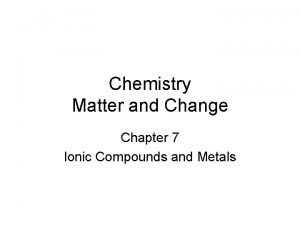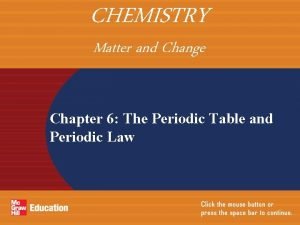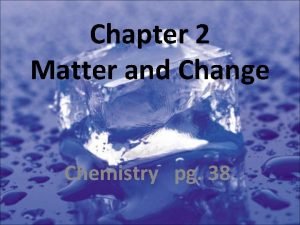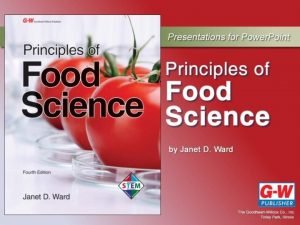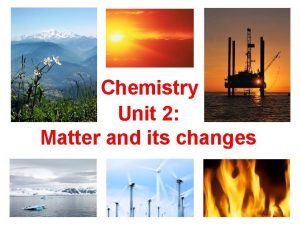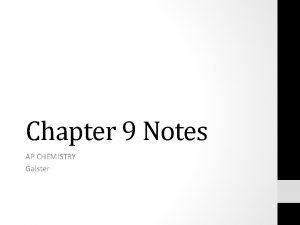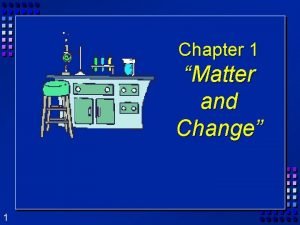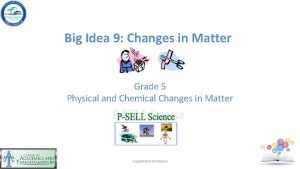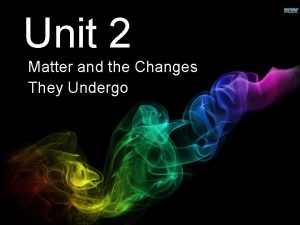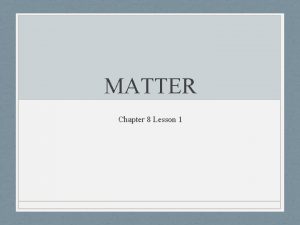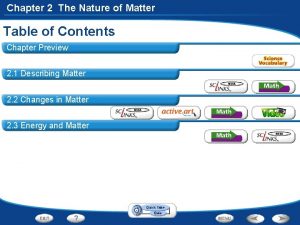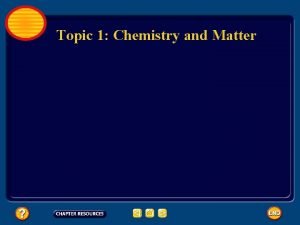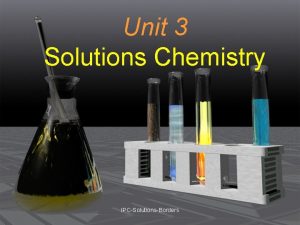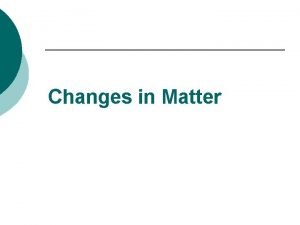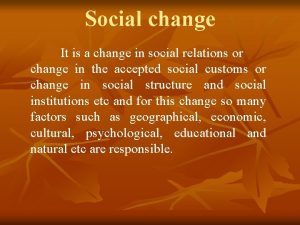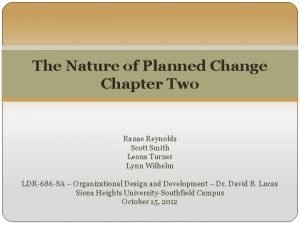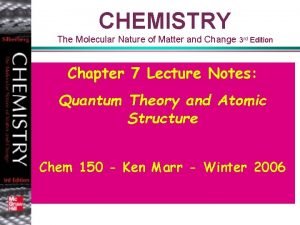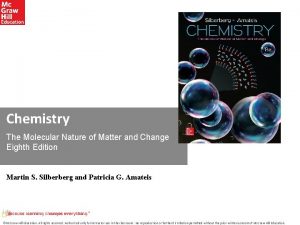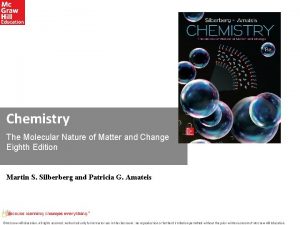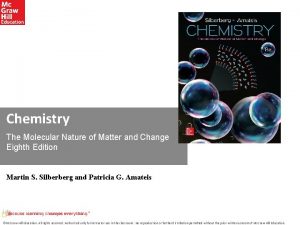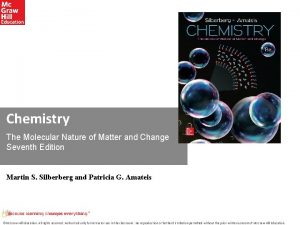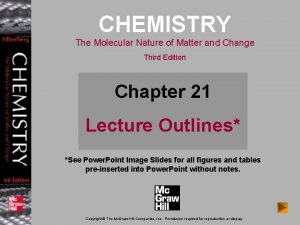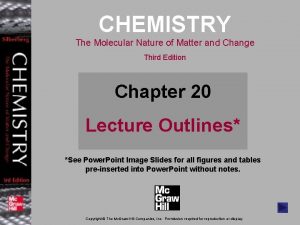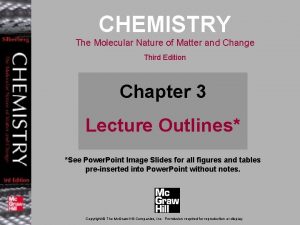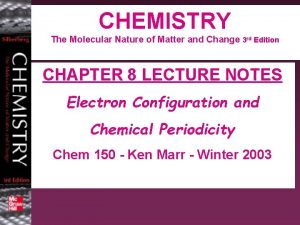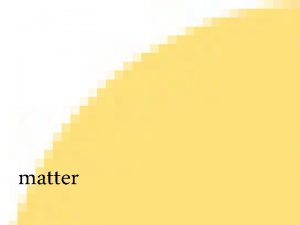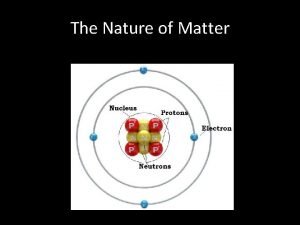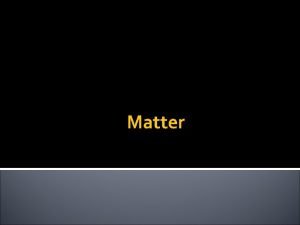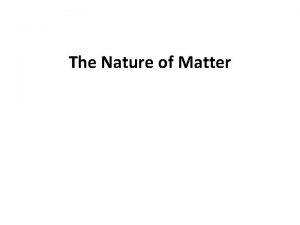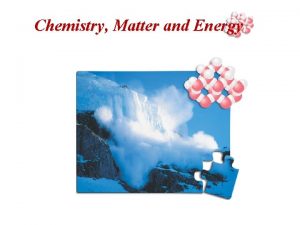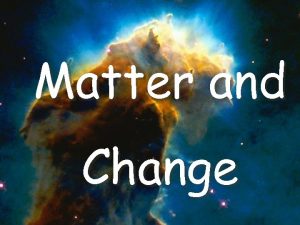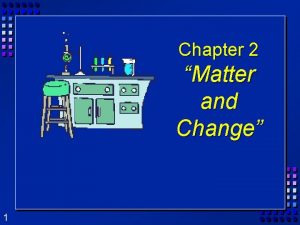Chemistry The Molecular Nature of Matter and Change


































































- Slides: 66

Chemistry The Molecular Nature of Matter and Change Seventh Edition Martin S. Silberberg and Patricia G. Amateis ©Mc. Graw-Hill Education. All rights reserved. Authorized only for instructor use in the classroom. No reproduction or further distribution permitted without the prior written consent of Mc. Graw-Hill Education.

Chapter 1: Keys to the Study of Chemistry • 1. 1 Some Fundamental Definitions • 1. 2 Chemical Arts and the Origins of Modern Chemistry • 1. 3 The Scientific Approach: Developing a Model • 1. 4 Measurement and Chemical Problem Solving • 1. 5 Uncertainty in Measurement: Significant Figures ©Mc. Graw-Hill Education.

Chemistry • Chemistry is the study of matter, its properties, the changes that matter undergoes, and the energy associated with these changes. ©Mc. Graw-Hill Education.

Definitions • Matter: anything that has both mass and volume – the “stuff” of the universe: books, planets, trees, professors, students • Composition: the types and amounts of simpler substances that make up a sample of matter • Properties: the characteristics that give each substance a unique identity ©Mc. Graw-Hill Education.

The States of Matter • A solid has a fixed shape and volume. Solids may be hard or soft, rigid or flexible. • A liquid has a varying shape that conforms to the shape of the container, but a fixed volume. A liquid has an upper surface. • A gas has no fixed shape or volume and therefore does not have a surface. ©Mc. Graw-Hill Education.

The Physical States of Matter • Fig 1. 1 ©Mc. Graw-Hill Education.

Physical and Chemical Properties • Physical Properties – properties a substance shows by itself without interacting with another substance – color, melting point, boiling point, density • Chemical Properties – properties a substance shows as it interacts with, or transforms into, other substances – flammability, corrosiveness ©Mc. Graw-Hill Education.

The Distinction Between Physical and Chemical Change • Fig 1. 2 ©Mc. Graw-Hill Education. (A) © Paul Morrell/Stone/Getty Images; (B) © Mc. Graw-Hill Education/Stephen Frisch, photographer

Sample Problem 1. 1 – Problem and Plan Visualizing Change on the Atomic Scale • PROBLEM: The scenes below represent an atomic-scale view of substance A undergoing two different changes. Decide whether each scene shows a physical or a chemical change. • PLAN: We need to determine what change is taking place. The numbers and colors of the little spheres that represent each particle tell its “composition”. If the composition does not change, the change is physical, whereas a chemical change results in a change of composition. ©Mc. Graw-Hill Education.

Sample Problem 1. 1 – Solution • SOLUTION: Each particle of substance A is composed of one blue and two red spheres. Sample B is composed of two different types of particles – some have two red spheres while some have one red and one blue. As A changes to B, the chemical composition has changed. A B is a chemical change. ©Mc. Graw-Hill Education.

Sample Problem 1. 1 – Solution, Cont’d • SOLUTION: Each particle of C is still composed of one blue and two red spheres, but the particles are closer together and are more organized. The composition remains unchanged, but the physical form is different. A C is a physical change. ©Mc. Graw-Hill Education.

Temperature and Change of State • A change of state is a physical change. – Physical form changes, composition does not. • Changes in physical state are reversible – by changing the temperature. • A chemical change cannot simply be reversed by a change in temperature. ©Mc. Graw-Hill Education.

Some Characteristic Properties of Copper • Table 1. 1 ©Mc. Graw-Hill Education. (copper) © Mc. Graw-Hill Education/Mark Dierker, photographer; (candlestick) © Ruth Melnick; (copper carbonate, copper reacting with acid, copper and ammonia) © Mc. Graw-Hill Education/Stephen Frisch, photographer

Sample Problem 1. 2 – Problem and Plan Distinguishing Between Physical and Chemical Change • PROBLEM: Decide whether each of the following processes is primarily a physical or a chemical change, and explain briefly: (a) Frost forms as the temperature drops on a humid winter night. (b) A cornstalk grows from a seed that is watered and fertilized. (c) A match ignites to form ash and a mixture of gases. (d) Perspiration evaporates when you relax after jogging. (e) A silver fork tarnishes slowly in air. • PLAN: “Does the substance change composition or just change form? ” ©Mc. Graw-Hill Education.

Sample Problem 1. 2 – Solution • (a) Frost forms as the temperature drops on a humid winter night – physical change • (b) A cornstalk grows from a seed that is watered and fertilized – chemical change • (c) A match ignites to form ash and a mixture of gases – chemical change • (d) Perspiration evaporates when you relax after jogging – physical change • (e) A silver fork tarnishes slowly in air – chemical change ©Mc. Graw-Hill Education.

Energy in Chemistry • Energy is the ability to do work. • Potential Energy is energy due to the position of an object. • Kinetic Energy is energy due to the movement of an object. Total Energy = Potential Energy + Kinetic Energy ©Mc. Graw-Hill Education.

Energy Changes • Lower energy states are more stable and are favored over higher energy states. • Energy is neither created nor destroyed – it is conserved – and can be converted from one form to another ©Mc. Graw-Hill Education.

Potential Energy is Converted to Kinetic Energy • A gravitational system. The potential energy gained when a weight is lifted is converted to kinetic energy as the weight falls. • A lower energy state is more stable. • Fig 1. 3 ©Mc. Graw-Hill Education.

Potential Energy is Converted to Kinetic Energy (2) by a spring. The potential • A system of two balls attached energy gained by a stretched spring is converted to kinetic energy when the moving balls are released. • Energy is conserved when it is transformed. • Fig 1. 3 ©Mc. Graw-Hill Education.

Potential Energy is Converted to Kinetic Energy, Cont’d • A system of oppositely charged particles. The potential energy gained when the charges are separated is converted to kinetic energy as the attraction pulls these charges together. • Fig 1. 3 ©Mc. Graw-Hill Education.

Potential Energy is Converted to Kinetic Energy, Further Cont’d • A system of fuel and exhaust. A fuel is higher in chemical potential energy than the exhaust. As the fuel burns, some of its potential energy is converted to the kinetic energy of the moving car. • Fig 1. 3 ©Mc. Graw-Hill Education.

Chemical Arts and the Origins of Modern Chemistry • Alchemy, medicine, and technology placed little emphasis on objective experimentation, focusing instead on mystical explanations or practical experience, but these traditions contributed some apparatus and methods that are still important. • Lavoisier overthrew the phlogiston theory by showing, through quantitative, reproducible measurements, that oxygen, a component of air, is required for combustion and combines with a burning substance. ©Mc. Graw-Hill Education.

The Scientific Approach to Understanding Nature • Fig 1. 6 ©Mc. Graw-Hill Education.

SI Base Units • Table 1. 2 ©Mc. Graw-Hill Education.

Common Decimal Prefixes Used With SI Units • Table 1. 3 ©Mc. Graw-Hill Education.

Common SI-English Equivalent Quantities • Table 1. 4 ©Mc. Graw-Hill Education.

Some Volume Relationships in SI • Fig 1. 7 ©Mc. Graw-Hill Education.

Common Laboratory Volumetric Glassware • Fig 1. 8 ©Mc. Graw-Hill Education.

Quantities of Length (A), Volume (B), and Mass (C) • Fig 1. 9 ©Mc. Graw-Hill Education.

Chemical Problem Solving • ©Mc. Graw-Hill Education.

Conversion Factors • ©Mc. Graw-Hill Education.

Conversion Factor Problem • ©Mc. Graw-Hill Education.

Systematic Approach to Solving Chemistry Problems • State Problem • Plan – Clarify the known and unknown. – Suggest steps from known to unknown. – Prepare a visual summary of steps that includes conversion factors, equations, known variables. • Solution • Check • Comment • Follow-up Problem ©Mc. Graw-Hill Education.

Sample Problem 1. 3 – Problem and Plan Converting Units of Length • PROBLEM: To wire your stereo equipment, you need 325 centimeters (cm) of speaker wire that sells for $0. 15/ft. What is the price of the wire? • PLAN: We know the length (in cm) of wire and cost per length ($/ft). We have to convert cm to inches and inches to feet. Then we can find the cost for the length in feet. ©Mc. Graw-Hill Education.

Sample Problem 1. 3 - Solution • ©Mc. Graw-Hill Education.

Sample Problem 1. 4 – Problem and Plan Converting Units of Volume • PROBLEM: A graduated cylinder contains 19. 9 m. L of water. When a small piece of galena, an ore of lead, is added, it sinks and the volume increases to 24. 5 m. L. What is the volume of the piece of galena in cm 3 and in L? • PLAN: The volume of the galena is equal to the difference in the volume of the water before and after the addition. ©Mc. Graw-Hill Education.

Sample Problem 1. 4 - Solution • ©Mc. Graw-Hill Education.

Sample Problem 1. 5 – Problem and Plan Converting Units of Mass • PROBLEM: Many international computer communications are carried out by optical fibers in cables laid along the ocean floor. If one strand of optical fiber weighs 1. 19 x 10 -3 lb/m, what is the mass (in kg) of a cable made of six strands of optical fiber, each long enough to link New York and Paris (a distance of 8. 94 x 103 km)? • PLAN: The sequence of steps may vary but essentially we need to find the length of the entire cable and convert it to mass. ©Mc. Graw-Hill Education.

Sample Problem 1. 5 - Solution • ©Mc. Graw-Hill Education.

Sample Problem 1. 6 – Problem and Plan Converting Units Raised to a Power • PROBLEM: A furniture factory needs 31. 5 ft 2 of fabric to upholster one chair. Its Dutch supplier sends the fabric in bolts that hold exactly 200 m 2. How many chairs can be upholstered with three bolts of fabric? • PLAN: We know the amount of fabric in one bolt in m 2; multiplying the m 2 of fabric by the number of bolts gives the total amount of fabric available in m 2. We convert the amount of fabric from m 2 to ft 2 and use the conversion factor 31. 5 ft 2 of fabric = 1 chair to find the number of chairs (see the road map). ©Mc. Graw-Hill Education.

Sample Problem 1. 6 - Solution • ©Mc. Graw-Hill Education.

Density • ©Mc. Graw-Hill Education.

Densities of Some Common Substances ©Mc. Graw-Hill Education.

Sample Problem 1. 7 – Problem and Plan Calculating Density from Mass and Volume • PROBLEM: Lithium, a soft, gray solid with the lowest density of any metal, is a key component of advanced batteries. A slab of lithium weighs 1. 49 x 103 mg and has sides that are 20. 9 mm by 11. 1 mm by 11. 9 mm. Find the density of lithium in g/cm 3. • PLAN: Density is expressed in g/cm 3 so we need the mass in g and the volume in cm 3. ©Mc. Graw-Hill Education.

Sample Problem 1. 7 –Plan, Cont’d ©Mc. Graw-Hill Education.

Sample Problem 1. 7 - Solution • ©Mc. Graw-Hill Education.

Some Interesting Temperatures • Fig 1. 10 ©Mc. Graw-Hill Education.

Freezing and Boiling Points of Water • Fig 1. 11 ©Mc. Graw-Hill Education.

Temperature Scales • Kelvin (K) – The “absolute temperature scale” begins at absolute zero and has only positive values. Note that the kelvin is not used with the degree sign (o). • Celsius (o. C) – The Celsius scale is based on the freezing and boiling points of water. This is the temperature scale used most commonly around the world. The Celsius and Kelvin scales use the same size degree although their starting points differ. • Fahrenheit (o. F) – The Fahrenheit scale is commonly used in the U. S. The Fahrenheit scale has a different degree size and different zero points than both the Celsius and Kelvin scales. ©Mc. Graw-Hill Education.

Temperature Conversions • ©Mc. Graw-Hill Education.

Sample Problem 1. 8 – Problem, Plan and Solution • ©Mc. Graw-Hill Education.

Extensive and Intensive Properties • Extensive properties are dependent on the amount of substance present; mass and volume, for example, are extensive properties. • Intensive properties are independent of the amount of substance; density is an intensive property. ©Mc. Graw-Hill Education.

Significant Figures • Every measurement includes some uncertainty. The rightmost digit of any quantity is always estimated. • The recorded digits, both certain and uncertain, are called significant figures. • The greater the number of significant figures in a quantity, the greater its certainty. ©Mc. Graw-Hill Education.

The Number of Significant Figures in a Measurement • Fig 1. 13 ©Mc. Graw-Hill Education.

Determining Which Digits Are Significant • All digits are significant – except zeros that are used only to position the decimal point. • Zeros that end a number are significant – whether they occur before or after the decimal point – as long as a decimal point is present. • 1. 030 m. L has 4 significant figures. • 5300. L has 4 significant figures. • If no decimal point is present – zeros at the end of the number are not significant. • 5300 L has only 2 significant figures. ©Mc. Graw-Hill Education.

Sample Problem 1. 9 – Problem and Plan Determining the Number of Significant Figures • PROBLEM: For each of the following quantities, underline the zeros that are significant figures (sf), and determine the number of significant figures in each quantity. For (d) to (f), express each in exponential notation first. (a) 0. 0030 L (b) 0. 1044 g (d) 0. 00004715 m (e) 57, 600. s (c) 53. 069 L (f) 0. 0000007160 cm 3 • PLAN: We determine the number of significant figures by counting digits, paying particular attention to the position of zeros in relation to the decimal point, and underline zeros that are significant. ©Mc. Graw-Hill Education.

Sample Problem 1. 9 - Solution • SOLUTION: (a) 0. 0030 L has 2 sf (b) 0. 1044 g has 4 sf (c) 53, 069 m. L has 5 sf (d) 0. 00004715 m = 4. 715 x 10 -5 m has 4 sf (e) 57, 600. s = 5. 7600 x 104 s has 5 sf (f) 0. 0000007160 cm 3 = 7. 160 x 10 -7 cm 3 has 4 sf ©Mc. Graw-Hill Education.

Rules for Significant Figures in Calculations • ©Mc. Graw-Hill Education.

Rules for Significant Figures in Calculations, Cont’d • ©Mc. Graw-Hill Education.

Rules for Rounding Off Numbers • 1. If the digit removed is more than 5, the preceding number increases by 1. – 5. 379 rounds to 5. 38 if 3 significant figures are retained. • 2. If the digit removed is less than 5, the preceding number is unchanged. – 0. 2413 rounds to 0. 241 if 3 significant figures are retained. • 3. If the digit removed is 5 followed by zeros or with no following digits, the preceding number increases by 1 if it is odd and remains unchanged if it is even. – 17. 75 rounds to 17. 8, but 17. 65 rounds to 17. 6. • If the 5 is followed by other nonzero digits, rule 1 is followed: – 17. 6500 rounds to 17. 6, but 17. 6513 rounds to 17. 7 ©Mc. Graw-Hill Education.

Rules for Rounding Off Numbers, Cont’d • 4. Be sure to carry two or more additional significant figures through a multistep calculation and round off the final answer only. ©Mc. Graw-Hill Education.

Significant Figures in the Lab • The measuring device used determines the number of significant digits possible. • Fig 1. 14 ©Mc. Graw-Hill Education.

Exact Numbers • Exact numbers have no uncertainty associated with them. • Numbers may be exact by definition: – 1000 mg = 1 g – 60 min = 1 hr – 2. 54 cm = 1 in • Numbers may be exact by count: – exactly 26 letters in the alphabet • Exact numbers do not limit the number of significant digits in a calculation. ©Mc. Graw-Hill Education.

Sample Problem 1. 10 – Problem and Plan • ©Mc. Graw-Hill Education.

Sample Problem 1. 10 - Solution • ©Mc. Graw-Hill Education.

Precision, Accuracy, and Error • Precision refers to how close the measurements in a series are to each other. • Accuracy refers to how close each measurement is to the actual value. • Systematic error produces values that are either all higher or all lower than the actual value. – This error is part of the experimental system. • Random error produces values that are both higher and lower than the actual value. ©Mc. Graw-Hill Education.
 Chemistry matter and change chapter 7
Chemistry matter and change chapter 7 Chapter 10 assessment the mole answer key
Chapter 10 assessment the mole answer key Chemistry matter and change chapter 7
Chemistry matter and change chapter 7 Chemistry matter and change chapter 6
Chemistry matter and change chapter 6 Chemistry matter and change chapter 10
Chemistry matter and change chapter 10 2 matter and change answer key
2 matter and change answer key Non examples of homogeneous mixture
Non examples of homogeneous mixture Chapter 4 basic food chemistry the nature of matter
Chapter 4 basic food chemistry the nature of matter Foods that are heterogeneous mixtures
Foods that are heterogeneous mixtures What is a covalent bond simple definition
What is a covalent bond simple definition Ionic covalent metallic
Ionic covalent metallic Zinc oxide + nitric acid → zinc nitrate + water
Zinc oxide + nitric acid → zinc nitrate + water What is the difference between gray and grey
What is the difference between gray and grey Label the cranial dura septa and associated sinuses.
Label the cranial dura septa and associated sinuses. Gray matter and white matter
Gray matter and white matter Gray matter vs white matter
Gray matter vs white matter Definition of substance
Definition of substance Democritus atomic model diagram
Democritus atomic model diagram Ap chemistry unit 9 notes
Ap chemistry unit 9 notes Nature and nature's laws lay hid in night meaning
Nature and nature's laws lay hid in night meaning Section 1 composition of matter
Section 1 composition of matter Section 1 composition of matter
Section 1 composition of matter Chapter 2 matter section 1 classifying matter answer key
Chapter 2 matter section 1 classifying matter answer key Classification of matter section 1 composition of matter
Classification of matter section 1 composition of matter Energy naturally flows from warmer matter to cooler matter
Energy naturally flows from warmer matter to cooler matter Chapter 1 review matter and change
Chapter 1 review matter and change Which is a big idea for matter and change
Which is a big idea for matter and change Unit 2 matter and change
Unit 2 matter and change Circle the solute and underline the solvent
Circle the solute and underline the solvent Chapter 8 lesson 1
Chapter 8 lesson 1 The nature of matter chapter 2
The nature of matter chapter 2 Examples of matter in chemistry
Examples of matter in chemistry Flowchart of matter
Flowchart of matter Flowchart undissolved solids
Flowchart undissolved solids Graphic organizer matter
Graphic organizer matter Nature nature controversy
Nature nature controversy Ib chemistry organic chemistry
Ib chemistry organic chemistry Organic vs inorganic chemistry
Organic vs inorganic chemistry Change of state of matter
Change of state of matter What are the two types of change in matter
What are the two types of change in matter Physical change and chemical change
Physical change and chemical change Absolute change and relative change formula
Absolute change and relative change formula Whats the difference between chemical and physical change
Whats the difference between chemical and physical change Change in supply and change in quantity supplied
Change in supply and change in quantity supplied Examples of physical vs chemical changes
Examples of physical vs chemical changes Rocks change due to temperature and pressure change
Rocks change due to temperature and pressure change Physical change and chemical change venn diagram
Physical change and chemical change venn diagram First and second order change in education
First and second order change in education Factor of social change
Factor of social change Nature of planned change
Nature of planned change Solid to liquid endothermic or exothermic
Solid to liquid endothermic or exothermic Hát kết hợp bộ gõ cơ thể
Hát kết hợp bộ gõ cơ thể Bổ thể
Bổ thể Tỉ lệ cơ thể trẻ em
Tỉ lệ cơ thể trẻ em Chó sói
Chó sói Glasgow thang điểm
Glasgow thang điểm Bài hát chúa yêu trần thế alleluia
Bài hát chúa yêu trần thế alleluia Môn thể thao bắt đầu bằng từ đua
Môn thể thao bắt đầu bằng từ đua Thế nào là hệ số cao nhất
Thế nào là hệ số cao nhất Các châu lục và đại dương trên thế giới
Các châu lục và đại dương trên thế giới Công của trọng lực
Công của trọng lực Trời xanh đây là của chúng ta thể thơ
Trời xanh đây là của chúng ta thể thơ Mật thư anh em như thể tay chân
Mật thư anh em như thể tay chân Làm thế nào để 102-1=99
Làm thế nào để 102-1=99 Phản ứng thế ankan
Phản ứng thế ankan Các châu lục và đại dương trên thế giới
Các châu lục và đại dương trên thế giới


